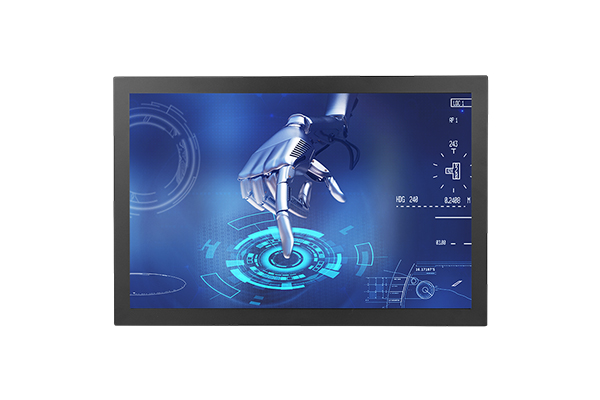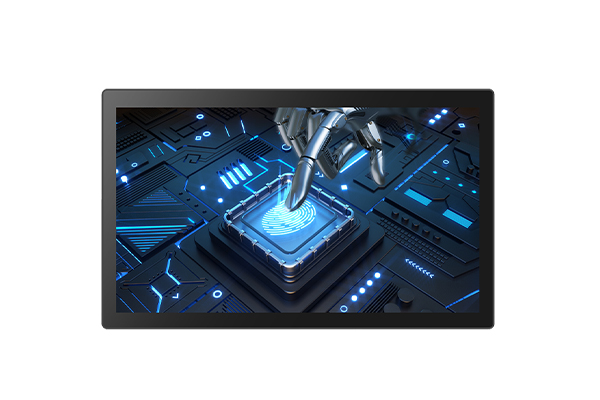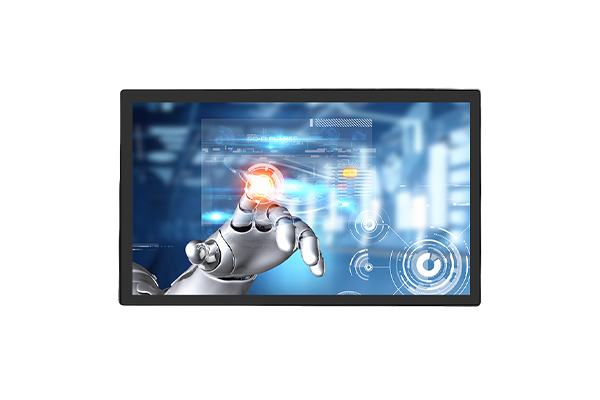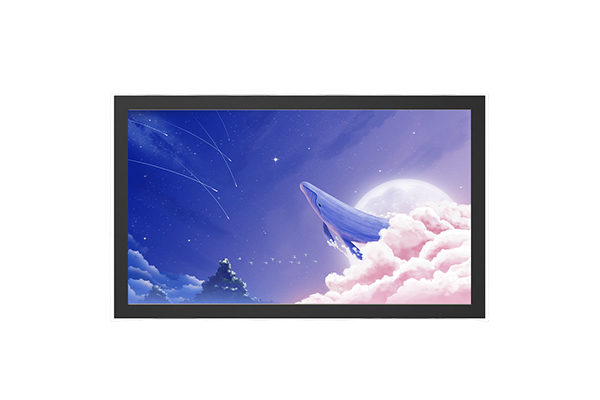How do open-frame touch monitors create an immersive visual experience?
Release Time : 2025-10-14
Driven by the wave of digitalization, human-computer interaction is shifting from passive viewing to active participation. As the core platform of a new generation of intelligent terminals, open-frame touch monitors have been widely used in smart offices, digital signage, industrial control, education, and healthcare. More than just a display screen, they are a comprehensive platform integrating visual presentation, touch interaction, and system integration. Their ability to create an immersive visual experience is key to engaging users and improving the efficiency of information transmission.
1. Borderless Design: Breaking Visual Boundaries and Expanding Field of View
Traditional monitors often suffer from a "picture frame effect" due to thick borders, confining content to a limited area and affecting overall visual scalability. Open-frame touch monitors generally adopt ultra-narrow or borderless designs, minimizing black borders on the screen. This minimizes gaps when multiple monitors are spliced together, achieving nearly seamless visual continuity. In conference systems or command centers, multiple open-frame touch monitors can be used side by side to create a wide information wall, allowing data, maps, or video content to flow naturally, creating an immersive viewing experience. This "bezel-less" design allows users to focus entirely on the content, rather than the device frame, significantly enhancing the sense of immersion.
2. Full-Lamination Process: Eliminates Halo and Enhances Picture Transparency
Open-frame touch monitors often utilize full-lamination technology, directly bonding the touchscreen layer to the LCD panel without an air gap. Compared to traditional "frame-laminated" screens, full-lamination technology effectively reduces light refraction and reflection between the multiple layers of glass, significantly reducing glare, ghosting, and the "glassy" feel. Even in bright sunlight, the image remains sharp and clear, with true-to-life color reproduction. Touchstrokes precisely overlap with the displayed content, delivering an intuitive "touch is what you see" experience. This high transparency and low-latency visual feedback is particularly suitable for interactive scenarios such as handwritten annotations, electronic signatures, and remote collaboration, allowing users to write as naturally and smoothly as if on paper.
3. High Resolution and Brightness: Delivering a Detailed and Authentic Picture
The foundation of immersion lies in image quality. Open-frame touch monitors generally support 2K, 4K, and even 8K ultra-high-definition resolutions, significantly increasing pixel density for sharp text edges, rich image detail, and grain-free viewing even from a distance. Furthermore, with screen brightness reaching 500–1000 nits, far exceeding typical monitors, ensuring clear visibility in brightly lit conference rooms, shopping malls, and even outdoors. Combined with a wide color gamut and high contrast, colors are more vivid and lifelike, creating a powerful visual impact for product presentations, video playback, and data visualization.
4. Multi-touch and Gesture Interaction: Make Operations "Immersive"
The immersive experience is more than just "seeing"; it's "participating." Open-frame touch monitors support 10 or even 20 touch points, allowing multiple users to operate simultaneously, enabling natural interactions like collaborative annotation, map zooming, and image scrolling. Users can pinch to zoom for details, swipe to switch pages, and circle to delete quickly, making operation intuitive and fun. In educational scenarios, students can solve problems directly on the screen, and teams can collaborate on revisions during design reviews. This "zero-distance" interaction breaks down the barrier between people and screens, allowing users to truly "enter" the content.
5. Flexible Installation and Open Integration: Adaptable to Diverse Scenarios
The open-frame touch monitor utilizes a VESA standard interface, adaptable to various mounting options, including wall-mounting, brackets, and embedded cabinets, easily integrating into conference rooms, exhibition halls, and control consoles. Its open architecture supports integration with OPS modules, PC hosts, or external devices, enabling flexible system expansion. Whether running conferencing software, playing promotional videos, or connecting to a surveillance system, content and interaction are seamlessly integrated, creating a highly customized immersive application environment.
With its borderless design, fully laminated technology, high-definition display, and natural touch interaction, the open-frame touch monitor successfully transcends the visual and operational limitations of traditional display devices, providing users with an unprecedented immersive experience. It is not only a window to information, but also a stage for interaction. With the convergence of AI, AR, and 5G technologies, future open-frame touch monitors will become even more intelligent and immersive, continuously redefining the boundaries of human-computer interaction.
1. Borderless Design: Breaking Visual Boundaries and Expanding Field of View
Traditional monitors often suffer from a "picture frame effect" due to thick borders, confining content to a limited area and affecting overall visual scalability. Open-frame touch monitors generally adopt ultra-narrow or borderless designs, minimizing black borders on the screen. This minimizes gaps when multiple monitors are spliced together, achieving nearly seamless visual continuity. In conference systems or command centers, multiple open-frame touch monitors can be used side by side to create a wide information wall, allowing data, maps, or video content to flow naturally, creating an immersive viewing experience. This "bezel-less" design allows users to focus entirely on the content, rather than the device frame, significantly enhancing the sense of immersion.
2. Full-Lamination Process: Eliminates Halo and Enhances Picture Transparency
Open-frame touch monitors often utilize full-lamination technology, directly bonding the touchscreen layer to the LCD panel without an air gap. Compared to traditional "frame-laminated" screens, full-lamination technology effectively reduces light refraction and reflection between the multiple layers of glass, significantly reducing glare, ghosting, and the "glassy" feel. Even in bright sunlight, the image remains sharp and clear, with true-to-life color reproduction. Touchstrokes precisely overlap with the displayed content, delivering an intuitive "touch is what you see" experience. This high transparency and low-latency visual feedback is particularly suitable for interactive scenarios such as handwritten annotations, electronic signatures, and remote collaboration, allowing users to write as naturally and smoothly as if on paper.
3. High Resolution and Brightness: Delivering a Detailed and Authentic Picture
The foundation of immersion lies in image quality. Open-frame touch monitors generally support 2K, 4K, and even 8K ultra-high-definition resolutions, significantly increasing pixel density for sharp text edges, rich image detail, and grain-free viewing even from a distance. Furthermore, with screen brightness reaching 500–1000 nits, far exceeding typical monitors, ensuring clear visibility in brightly lit conference rooms, shopping malls, and even outdoors. Combined with a wide color gamut and high contrast, colors are more vivid and lifelike, creating a powerful visual impact for product presentations, video playback, and data visualization.
4. Multi-touch and Gesture Interaction: Make Operations "Immersive"
The immersive experience is more than just "seeing"; it's "participating." Open-frame touch monitors support 10 or even 20 touch points, allowing multiple users to operate simultaneously, enabling natural interactions like collaborative annotation, map zooming, and image scrolling. Users can pinch to zoom for details, swipe to switch pages, and circle to delete quickly, making operation intuitive and fun. In educational scenarios, students can solve problems directly on the screen, and teams can collaborate on revisions during design reviews. This "zero-distance" interaction breaks down the barrier between people and screens, allowing users to truly "enter" the content.
5. Flexible Installation and Open Integration: Adaptable to Diverse Scenarios
The open-frame touch monitor utilizes a VESA standard interface, adaptable to various mounting options, including wall-mounting, brackets, and embedded cabinets, easily integrating into conference rooms, exhibition halls, and control consoles. Its open architecture supports integration with OPS modules, PC hosts, or external devices, enabling flexible system expansion. Whether running conferencing software, playing promotional videos, or connecting to a surveillance system, content and interaction are seamlessly integrated, creating a highly customized immersive application environment.
With its borderless design, fully laminated technology, high-definition display, and natural touch interaction, the open-frame touch monitor successfully transcends the visual and operational limitations of traditional display devices, providing users with an unprecedented immersive experience. It is not only a window to information, but also a stage for interaction. With the convergence of AI, AR, and 5G technologies, future open-frame touch monitors will become even more intelligent and immersive, continuously redefining the boundaries of human-computer interaction.









